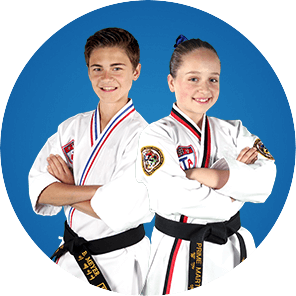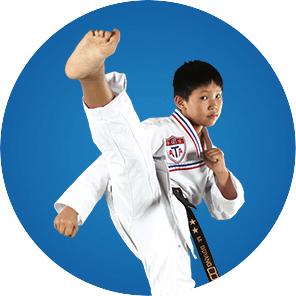Sparring
Exclusive Web Offer
Act Now
Limited Spots Available
We respect your privacy and will NEVER sell, rent
or share your email address.
Limited Spots Available
We respect your privacy and will NEVER sell, rent
or share your email address.
ATA's primary goal for its students in sparring matches is to be safe and have fun. To do that, competitors and spectators are to follow these rules and guidelines:
All sparring students are expected to wear ATA-approved equipment:
• Head gear
• Face shield
• Chest guard
• Foot gear
• Hand gear
• Mouth guard
• Protective cup (for males)
Students and their parents will practice good sportsmanship by showing discipline, courtesy, and respect. They will refrain from signs of frustration, disgust, or dissatisfaction with the outcome of matches, and they will not show over-exuberance should they or their student win a match.
• Purposely running out of bounds to avoid the match or fall down to avoid contact or otherwise delaying a match. Going out of bounds or falling in the normal course of the match will sometimes happen. Competitors should know where they are in relation to the ring boundary.
• Performing fakes to illegal targets
• Grabbing or holding an opponent, but swatting or closed-hand blocking away kicks and punches is fine.
• Receiving coaching. Positive cheering is welcome and encouraged. If a spectator is coaching, the chief judge will stop the match and remind them of the rules. Should the coaching continue, the spectator will be asked to leave the ring side or the competition area.
A student always has the right, and the responsibility, to limit the amount of contact during a sparring match. Although color belt sparring is ideally noncontact, contact does occur. If you are uncomfortable with the amount of contact or power, it is your right, and responsibility, for you to ask for less contact or power. No one else will ask for you.
The diagram below shows how points are scored in a tournament.
The winner of a sparring match is the competitor who is the first to earn five points or has the greater number of points at the end of two minutes. If the match is tied after two minutes, it enters "sudden victory": the competitor who gets the next point wins.
For a point or no point/block call to be made, a judge must observe the point (or block/no point). If the judge does not see the contact in question, he can call only "no see," even if it's obvious that contact was made. Judges must see the point they call.
Judges sometimes make mistakes, but they are never wrong. They do the best job they can with the views they have, watching two fast-moving people throwing kicks and punches at each other. Competitors and spectators should remember the judges only see a small part of the sparring match at any instant. Spectators have different views, and they will often see things the judges do not. If there is a legitimate concern, feel free to bring it to the attention of someone at the tournament's head table.
ATA Tigers - boys and girls up to age 6 - participate in simplified sparring matches. Each competitor gets two sparring matches, each lasting 30 to 60 seconds. Each match is interrupted a couple of times, and although no points are awarded, each competitor is told about something good they did in that segment. Students must still wear a complete set of sparring gear.
The same protective equipment is required for a combat sparring match as with a traditional sparring match: helmet, face shield, mouth guard, chest protector, kicks (foot pads), and male protective gear for the males. The difference is the gloves. For competition at regional, national, or world tournaments, competitors are required to wear special combat sparring gloves. These are predominantly white, have the word "combat" printed on the back, and other than the fingertips, little padding on the inside. This design allows a good grip of the weapon while providing ample padding on the outside of the hand. In class or in-school tournaments, your instructor may allow the use of your traditional sparring gloves (pull out your fingers from the glove grips for a better hold on the handle) or "bag gloves" (an older style of gloves which were used primarily for bag work).
Weapon sparring is done with a special bahng mahng ee, normally colored blue. These are not the same ones which we train within our weapons classes. These bahng mahng ees are longer and are padded so a moderate-strength hit to a legal nonpadded body part will not cause serious injury. (If you try weapon sparring with a standard bahng mahng ee, it will hurt, so please don't.) They're basically nylon-covered pool noodles on sticks. A combat sparring stick must be in good condition: It must have no tears or holes in the fabric, the padding part of the weapon should not move along the stick, and the supporting stick inside the padded portion should completely fill the padding.
Unlike in traditional sparring, where only the chest and head are targets, the entire body (with a few exceptions) is a target. A competitor's legs, arms, and back are all in play for points. Therefore one should avoid using their body to block attacks by their opponent because it probably will result in point(s) for your opponent.
The following are illegal targets in weapon sparring. The penalties in combat sparring for motions or strikes to illegal targets are the same as those for traditional sparring.
• All sides of the neck
• A horizontal strike to the eyes which might go through the hole in the sparring face shield
• The groin
A direct strike on a blocking body part would likely result in a point for the striker, a deflection does not count as a hit. For a strike to be deflected, the angle of the strike should not change appreciably. How much this is depends on the judges.
The conditions which end of a weapon sparring match are the same as those which end a traditional sparring match save one: The maximum number of points in a combat sparring match is 10. (It's 5 points in traditional sparring.)
As mentioned earlier, the entire body (with a few exceptions) is a target. Except for the following strikes, all other strikes are worth 1 point:
• Head: 2 points
• The forearm of the hand which contains the weapon: 2 points
• A stab to the front leg: 2 points
As with traditional sparring, jumping adds a point. For example, a jumping headshot is 3 points (2 for the head + 1 for the jump), a jump strike to the back is 2 points (1 for the strike + 1 for the jump).
There is one more important way that points can be scored: dropping the weapon. However, this works against you. That is, if you drop your weapon, it gives 1 point to your opponent. This is in addition to any points they might get from a strike they made on you. For example, a jump with a strike to your opponent's weapon forearm which causes them to drop their weapon will result in your earning 4 points: 2 for the hit to the weapon forearm + 1 for the jump + 1 for their weapon drop.
Safety first, always.
Warnings can (and often will) be issued to a competitor who uses excessive power, repeatedly runs out of the ring to escape an opponent's attacks, or feints or contacts an illegal target. This latter action (illegal contact) will likely result in a point for the other competitor.
If contact to an illegal target is thought to be incidental and an attempt was made to avoid it, an oral warning might be given with an explanation; it's likely no penalty point will be issued. For more blatant illegal moves, whether intentional or not, the first occurrence can result in an oral warning, unless contact was made, in which case a point will be awarded to the other competitor. The second occurrence of any illegal move is a point for the other competitor (or disqualification if a point has been awarded already). The third occurrence in a match will cause that competitor to be disqualified.
ATA's primary goal for its students in sparring matches is to be safe and have fun. While sparring is ideally noncontact, contact does frequently happen. It's up to you, as a competitor, to ask the judge to keep the contact down if you feel it's too much. Competitors must wear all appropriate and approved protective equipment.

Mike Chat, an accomplished competitive martial artist and ATA Fourth Degree Black Belt who played one of the Mighty Morphin' Power Rangers on TV, created ATA Xtreme (also known as XMA or Xtreme Martial Arts.)
He describes the program as "the ability to perform highly skilled moves and also the ability to perform basic moves and make them look spectacular!"
This is why XMA is not only for the elite level athletes and competitors but also for beginners at the entry level as well.

Positive Mental Attitude

High Goal-Setting

Respect & Self-Confidence
The country’s largest martial arts organization.

130,000 active members & over 1 million students trained since 1969.
Each instructor has passed an intensive certification process based on 40 years of tradition, research & development.

is a victim of bullying

in the U.S. try drugs

fail to graduate on time
Since 1969, over one million students have trained in one of the 950 ATA Licensed schools. Our students regularly go on to join Ivy schools and become community leaders. The values they learn during their martial arts journey are the same you teach at home and last a lifetime.

Social interaction teaches kids how to effectively work as part of a team.

Martial arts helps improve coordination and is an excellent form of exercise.

Building healthy habits early on can help prevent obesity and diabetes later in life.

Our ATA Tigers program is for ages 4-6, while our Martial Arts for Kids and Sparring programs are for ages 7-12.
We offer month-to-month memberships, as well as savings on longer plans.
You will receive an email with instructions on how to schedule your first class. One of our instructors will call you, or you may call the school directly.
Absolutely not. Although they will learn cool martial arts and self-defense moves, your child will learn how to AVOID fights, not pick them.
Our Martial Arts classes' primary goal is to make sure our students have fun in a playful, safe environment. Come and see a class for yourself - the kids have a blast and our instructors do too.
No, our classes are a good mix of boys and girls of all fitness levels. Beginners train alongside some of the more experienced kids, helping each other out in a fun team environment.